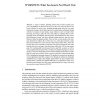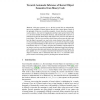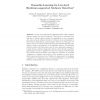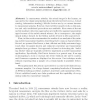76
Voted
RAID
2015
Springer
9 years 8 months ago
2015
Springer
As new code-based defense technologies emerge, attackers move to data-only malware, which is capable of infecting a system without introducing any new code. To manipulate the contr...
88
Voted
RAID
2015
Springer
9 years 8 months ago
2015
Springer
Abstract. A variety of attacks, including remote-code execution exploits, malware, and phishing, are delivered to users over the web. Users are lured to malicious websites in vario...
94
Voted
RAID
2015
Springer
9 years 8 months ago
2015
Springer
A small part of the IPv4 address space has still not been assigned for use to any organization. However, some of this IP space is announced through BGP, and is, therefore, globally...
96
Voted
RAID
2015
Springer
9 years 8 months ago
2015
Springer
Cache attacks, which exploit differences in timing to perform covert or side channels, are now well understood. Recent works leverage the last level cache to perform cache attacks...
91
Voted
RAID
2015
Springer
9 years 8 months ago
2015
Springer
This paper presents ARGOS, the first system that can automatically uncover the semantics of kernel objects directly from a kernel binary. Based on the principle of data use reveal...
89
Voted
RAID
2015
Springer
9 years 8 months ago
2015
Springer
Abstract. Software systems are often engineered and tested for functionality under normal rather than worst-case conditions. This makes the systems vulnerable to denial of service ...
79
Voted
RAID
2015
Springer
9 years 8 months ago
2015
Springer
Abstract. Program anomaly detection analyzes normal program behaviors and discovers aberrant executions caused by attacks, misconfigurations, program bugs, and unusual usage patte...
RAID
2015
Springer
9 years 8 months ago
2015
Springer
Recent work demonstrated hardware-based online malware detection using only low-level features. This detector is envisioned as a first line of defense that prioritizes the applica...
79
Voted
RAID
2015
Springer
9 years 8 months ago
2015
Springer
In this paper, we present the design and implementation of Haetae, a high-performance Suricata-based NIDS on many-core processors (MCPs). Haetae achieves high performance with thre...
86
Voted
RAID
2015
Springer
9 years 8 months ago
2015
Springer
In ransomware attacks, the actual target is the human, as opposed to the classic attacks that abuse the infected devices (e.g., botnet renting, information stealing). Mobile device...





